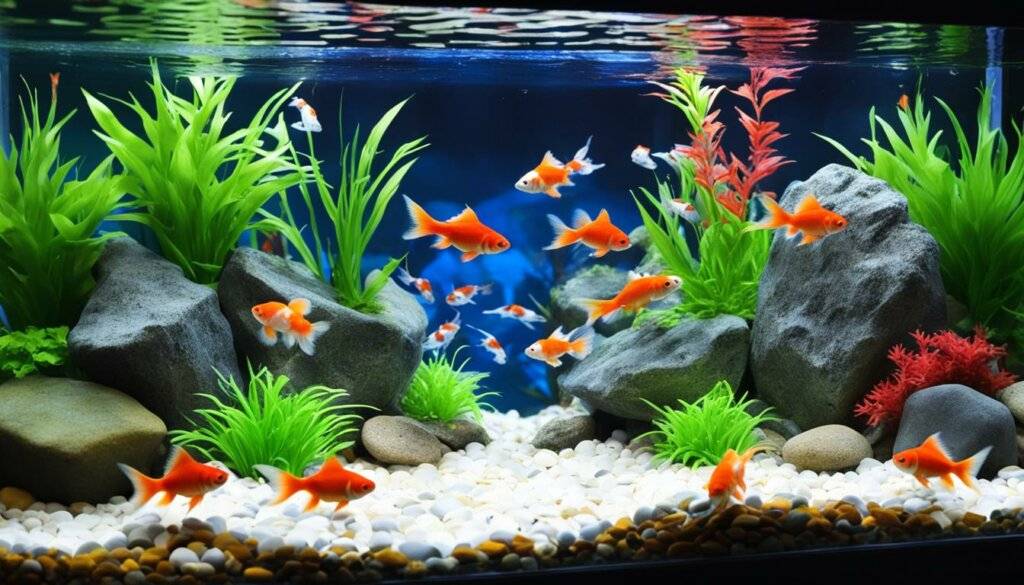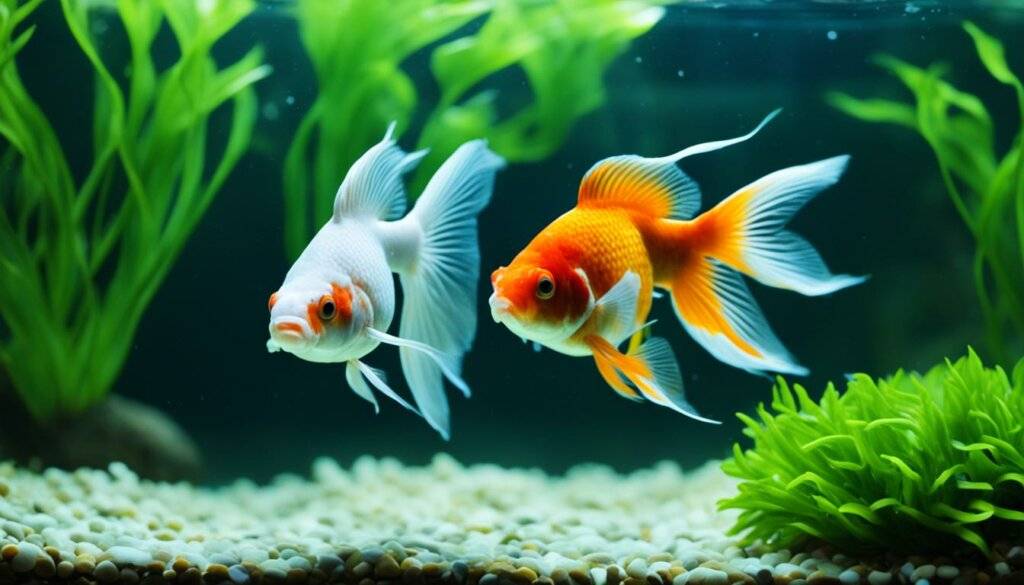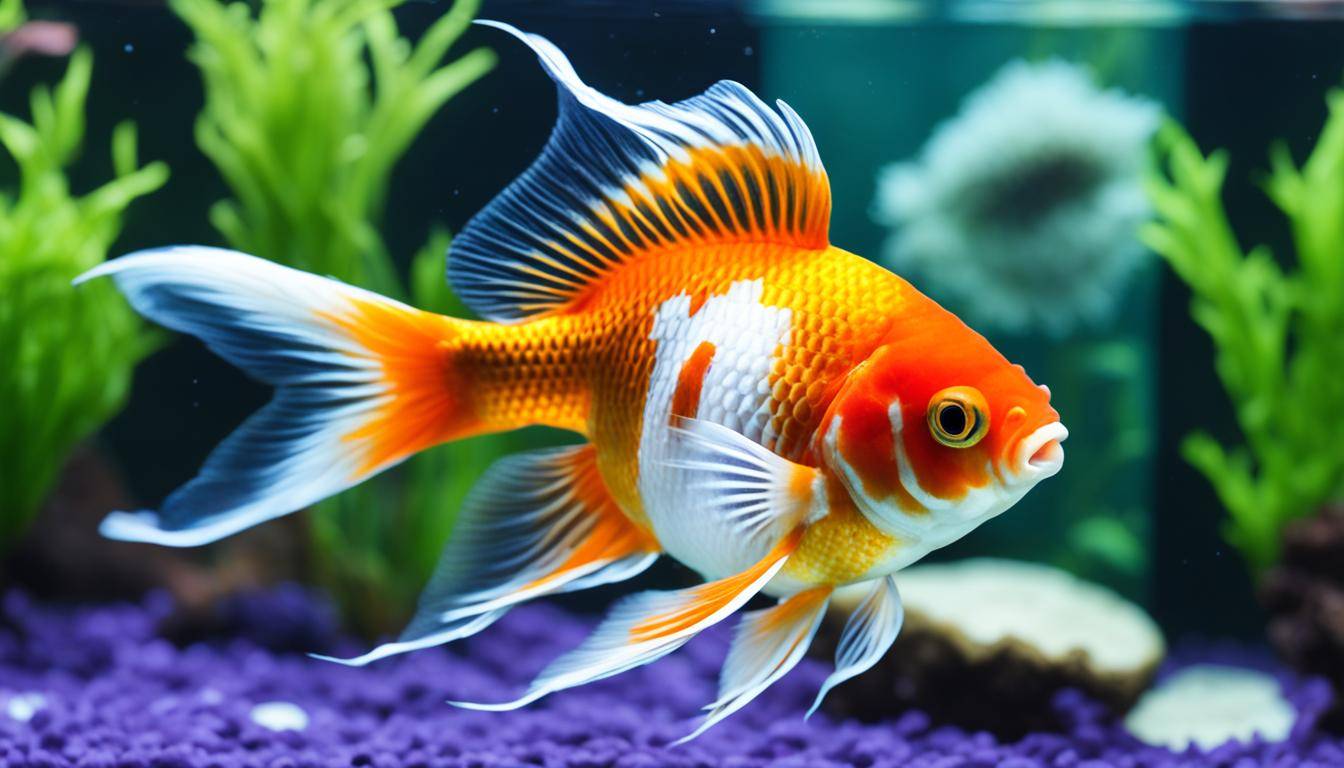Picture this: looking into your aquarium and seeing the soothing dance of the Oranda goldfish. This elegant type makes your tank look royal. They’re easy to take care of, and their unique wen looks like a crown.
These fish are perfect for both beginners and experts. They’re full of personality and charm. With colors ranging from “red capped” to calico, they brighten your tank. This guide will help you make a perfect home for them.
Key Takeaways
- The Oranda goldfish is recognized for its unique wen and is a prized addition to your home aquarium.
- Offering ease of care, Oranda goldfish make fantastic pets for both beginner and experienced fish enthusiasts.
- These fancy goldfish species display a variety of colors, enhancing the aesthetic of any aquatic setting.
- With a lifespan of 5-10 years, investing in oranda goldfish care promises long-term companionship.
- Understanding the social and environmental needs of Oranda goldfish is key to their thriving existence.
Introduction to Oranda Goldfish as Fancy Aquatic Pets
If you’re thinking about becoming an aquarist, you may find the Oranda goldfish interesting. They’re known for being both beautiful and tough. This section explores why the Oranda is a favorite among fancy goldfish breeds. They are also perfect for anyone new to fishkeeping, making any home aquarium lively.
Understanding the Popularity of Oranda Goldfish
Oranda goldfish are more than just pretty fish. They are loved by both beginners and expert fish keepers for their friendly nature. The wen on their head, looking like a crown, makes them stand out. This unique feature has made them a top choice for many.
What Sets Oranda Goldfish Apart From Other Goldfish Varieties
Oranda goldfish are special not only because of their wen but also their colors and patterns. They move slowly, which helps create a peaceful tank environment. As they get along with other calm fish, they help make a tank tranquil and friendly.
| Traits | Impact on Popularity as a Pet |
|---|---|
| Unique Wen | Contributes to a royal and distinctive look |
| Color Diversity | Offers visual intrigue and variety |
| Social Behavior | Facilitates compatibility with other peaceful fish |
| Diet Flexibility | Makes them undemanding in terms of feeding |
| Beginner-friendly Maintenance | Allows easy care, ideal for those new to keeping fish |
Oranda goldfish mix elegance and ease in a unique way. They can make any aquarium better with their beauty. Whether you’re just starting or want to add elegance to your tank, think about the Oranda goldfish. They are beloved pets that add life and color to your water world.
The Distinctive Physical Features of Oranda Goldfish
The Oranda goldfish is a standout in the ornamental fish world. Its signature wen growth makes it a favorite. This growth looks like a crown and may cover the fish’s eyes, making each one unique.
The wen is just one remarkable feature. Oranda color variations offer a rainbow of reds to blues, and calico. Their metallic or nacreous scales sparkle with these colors, enhancing the beauty of any aquarium.
But there’s more to the Oranda. They have a stout, rounded body and long, flowing fins, including a distinctive double tail. This makes them stand out even more among other fish.
What makes the Oranda goldfish captivating includes:
- Expansive wen growth resembling a raspberry hat
- Diverse hues encapsulating Oranda color variations from single to multi-colored patterns
- Classic goldfish silhouette with trademark ornamental goldfish traits
- Dorsal, caudal, and pectoral fins that create a graceful water display
For anyone, seeing an Oranda goldfish is like having a living artwork. Their unique wen, bright colors, and beauty make the Oranda a prized fish in aquariums.
Unraveling the History: How Oranda Goldfish Became a Hobby Favorite
The Oranda Goldfish, with its enchanting wen and vibrant colors, comes from a deep Chinese goldfish history. This fish’s journey started in China’s ponds and now, they’re a favorite in home aquariums. Explore the fascinating story of goldfish domestication.
The Ancestral Roots of Oranda Goldfish
The story of the Oranda Goldfish begins with the Prussian carp. Through selective breeding goldfish methods in China, these wild fish transformed. Crafty breeding over generations gave us the beautiful Orandas we love.
Oranda Goldfish Through the Ages
Over time, the Oranda Goldfish became a sign of wealth and elegance. Their role in Chinese culture and worldwide reflects the hard work of selective breeding goldfish enthusiasts. These breeders turned them into the beloved pets we have today.
| Period | Developments in Oranda Goldfish History |
|---|---|
| Ancient China | Origination from wild carp; beginning of domestication and selective breeding |
| Song Dynasty | Recognition of goldfish as ornamental pets; initial shaping of the Oranda breed |
| Ming/Qing Dynasty | Advancements in selective breeding; refinement of the Oranda’s distinctive features |
| 20th Century to Present | Global spread and increased popularity; the Oranda becomes a staple in home aquariums |
Caring for Your Oranda Goldfish: Tank Setup and Requirements
Setting up a tank for your Oranda goldfish means more than just adding water. You need to create a home that feels like the calm lakes they come from. This includes the right amount of space, decorations, and taking care of the water.
| Tank Capacity and Dimensions | Substrate and Decoration | Water Parameters | Filtration and Maintenance |
|---|---|---|---|
| Minimum of 20 gallons with ample swimming space | Soft, non-abrasive substrate and injury-proof decorations | Temperature: 65°F – 75°F pH: 6.5 – 7.5 |
Efficient filtration system with regular cleaning schedule |
Everything in your tank affects your goldfish’s health. A smooth substrate is like the lakebeds they love. The right water temperature and pH keep them healthy. Also, a good filter system cleans the water and keeps it moving, which they enjoy.

-
Save
Your goldfish’s bright colors and activity need enough room. Goldfish can pollute the water quickly if the tank is too full. So, having a good filter and cleaning regularly is important. This way, your beautiful goldfish will live happily in a piece of nature you’ve made at home.
By following these tank setup rules and caring for the aquarium, your goldfish will live a long and healthy life. They will become a beautiful part of your home, swimming in their perfect tank.
Feeding Your Oranda Goldfish: A Balanced Diet for Optimal Health
Good goldfish nutrition is crucial for your Oranda Goldfish’s health and long life. It’s important to mix commercial foods with live or frozen snacks and greens. This mix gives your pet a variety of food choices. Managing their diet well means your Oranda gets exactly what it needs.
Identifying Suitable Foods for Oranda Goldfish
The health of your Oranda depends on what it eats. A good diet includes top-notch commercial flakes or pellets and natural foods. Bloodworms and brine shrimp help them grow, while veggies like peas and lettuce offer fiber and minerals.
Feeding Techniques and Portion Control
How and how much you feed your Oranda affects its health. Feeding small amounts many times a day prevents overeating and digestive problems. What does “small amounts” mean? Check the table below.
| Food Type | Portion Size | Frequency |
|---|---|---|
| High-quality Pellets | About 3% of fish’s body weight | Twice daily |
| Live/Frozen Foods | One cube or equivalent | 2-3 times per week |
| Vegetables | One small piece per fish | 2-3 times per week |
Watch how your Oranda eats and adjust its diet to help it thrive. With moderation and careful diet management, your fish will be healthy and a pleasure to observe.
The Social Behavior and Interactivity of Oranda Goldfish
Watching Oranda goldfish in an aquarium community is fascinating. These creatures are peaceful and social. They swim smoothly with others, showing their friendly nature.
As their caretaker, it’s your job to help them find the right friends. Pick tank mates that are calm and won’t bully your Orandas at meal times.
Here are some behaviors that show their sociability:
- Gentle navigation around the aquarium, often in the company of others
- Shared foraging sessions during feeding, displaying collective patience
- Pair bonding, at times noticeable through synchronized swimming patterns
| Behavior | Interaction Type | Notes |
|---|---|---|
| Group Swimming | Cooperative | Orandas often swim in groups, adhering to a ‘follow the leader’ dynamic. |
| Feeding Time | Communal | They tend to feed peacefully alongside tank mates, rarely displaying aggression. |
| Courting | Affectionate | A distinct dance performed during mating season, including gentle nudging. |
These behaviors are more than just actions. They ensure your goldfish are happy and healthy. A tank that promotes social interaction helps Orandas show their peaceful nature.
Watching your Orandas peacefully interact shows their elegance. By choosing the right species and caring for their needs, your tank can be a peaceful aquarium community.
Common Health Considerations for Oranda Goldfish
Keeping your Oranda goldfish health in top shape is key. It’s vital for its long life and the health of your tank. Know the common health problems they face and how to prevent them. Disease prevention helps your Oranda do well in its home.
Preventing and Identifying Potential Illnesses
Watch your Oranda goldfish closely. Any change in how they look or act could mean health issues. Catching and treating problems like infections early is crucial. Here’s a guide to spot and fix health problems:
| Signs of Illness | Preventive Measures | Immediate Action |
|---|---|---|
| Cloudy or fuzzy patches on the skin | Regular water quality checks | Consultation with a vet and water condition adjustment |
| Erratic swimming or floating | Proper diet control | Appropriate fasting and dietary adjustments |
| Swelling or redness of the wen | Maintain clean substrate | Isolate the fish and commence treatment |
| Bulging eyes | Consistent tank cleaning | Balance electrolytes and investigate underlying causes |
The Importance of Water Quality in Oranda Health
Good water quality is crucial for your goldfish’s health. Great water prevents diseases and is key to aquatic pet wellness. Follow these tips to keep their home clean:
- Test water parameters constantly to quickly find any issues.
- Change water often, about 20-30% every week, to avoid toxins.
- Use a strong filtration system to maintain clean, oxygen-rich water.
- Quarantine new fish before adding them to the main tank to stop diseases.
By keeping their environment clean and watching for diseases, your Oranda goldfish can stay healthy. This way, it’ll be a beautiful part of your aquarium for a long time.
Oranda Goldfish Breeding Essentials
Starting to breed Oranda Goldfish is a rewarding journey. It needs knowledge and passion. You must know their breeding patterns, pick the right pair, and create a similar-to-nature setting for their breeding. This helps bring forth the next generation.

-
Save
Firstly, adjust the water’s temperature to boost spawning. This temperature change makes the fish start their courtship dance. You should watch this closely. Also, feeding them high-quality proteins is key for their eggs and sperm.
When you see signs they are ready to mate, like chasing, they need a private spot. Privacy is important for their breeding success. Below is a table with the conditions to achieve during this vital period:
| Condition | Importance | Optimal Range |
|---|---|---|
| Water Temperature | Encourages spawning | 68-74°F (20-23°C) |
| Nutritional Provisioning | Supports gamete development | High protein diet |
| Tank Privacy | Facilitates successful mating | Separate breeding tank |
| Observation of Behaviors | Ensures timely intervention | Regular monitoring |
After successful breeding, care for the fry is crucial. A clean tank without strong currents and with the right feed gives them a great start. Your care helps keep the species going and adds to their diversity.
Aquarium Companions: Compatible Tank Mates for Oranda Goldfish
Adding new friends to your aquarium is exciting. Yet, keeping aquarium harmony matters most. When picking goldfish tank mates for your Oranda, choose species that are calm. They shouldn’t be bullies or fin-nippers.
Selecting Peaceful and Compatible Species
For a peaceful tank, your choices are crucial. Snails like Nerite or Mystery, along with certain shrimp, fit well. They’re interesting but don’t start trouble. Zebra Danios or White Cloud Minnows are also good. They’re gentle and need water like your Oranda does.
Understanding the Social Needs of Oranda Goldfish
Your Oranda Goldfish likes a peaceful home. Friends for them should not be pushy or greedy during mealtime. Fish with long fins or slow swimmers are best. They give your Oranda space, keeping aquarium harmony and letting all fish live well together.
| Oranda Goldfish Tank Mate | Compatibility Reason |
|---|---|
| Rubber Lip Pleco | Peaceful algae eater; does not disturb Orandas |
| Nerite Snails | Help keep the tank clean, peaceful cohabitants |
| Zebra Danios | Fast swimmers and stay mostly in the upper part of the tank |
| White Cloud Mountain Minnows | Peaceful, small, and prefer cooler water, like Orandas |
| Boesemani Rainbow | Vibrant and active, but peaceful and unobtrusive |
Accessorizing Your Aquarium: Decorations and Plants for Oranda Goldfish
When you start decorating your aquarium, picking goldfish safe decorations and plants for Oranda Goldfish is important. These decorations do more than just look good. They help keep your goldfish healthy and happy. By choosing the right items, you make sure your aquarium is both beautiful and good for your fish.
Using smooth rocks and driftwood can set the theme of your aquarium. They offer places for your goldfish to explore and rest. With the right accessories, your aquarium will look polished and match the peaceful vibe of your Oranda Goldfish. Also, adding plants, no matter if they’re real or fake, creates a better space for your fish to act naturally.
Designing your aquarium with style and function in mind is important for Oranda Goldfish. Real plants help keep the water clean, but fake plants are easier to look after. Either way, your tank will have the lush look of the wild underwater world.
| Decoration Type | Benefits | Maintenance Level |
|---|---|---|
| Smooth Rocks | Harbors beneficial bacteria and adds a naturalistic touch | Low – Occasionally rinse during water changes |
| Driftwood | Provides hiding spots and mimics natural habitat | Medium – May require pre-soaking to prevent tannins from coloring water |
| Live Plants | Enhances oxygen levels and offers a dynamic environment | High – Requires substrate fertilization and proper lighting |
| Artificial Plants | Consistent appearance with no risk of parasites or disease | Low – Simple cleaning during tank maintenance |
When setting up a plant life habitat, think about looks and function. Plants like Anubias, Java Ferns, and Hornwort need care but create a beautiful scene. Mixing different types and heights of plants will make your aquarium design interesting.
It’s important to avoid decorations that could hurt your Oranda Goldfish. They have delicate fins that can get hurt by sharp objects. So, make sure every decoration is safe and smooth to protect your goldfish.
Decorating your tank is a chance to mix your creativity with your goldfish’s needs. Take time to choose decorations that are both pretty and make a safe plant life habitat. By doing so, you build a lovely space that you and your fish will enjoy.
The Oranda Goldfish: An Elegant Showstopper for Your Home Aquarium
Start keeping Oranda Goldfish and see why they’re top in style and perfect for aquariums. Their fancy wen adds lots of charm, turning them into true water jewels. They’re not just pets, but living art. Orandas bring color and calm to your home, a break from the daily rush.
Care for your Oranda right to see them at their best. From a big tank to varied food, their health is in your hands. A setup with plants and room to swim lets them show their grace. A good environment is key for their energy and long life.
The beauty of Oranda Goldfish is in their looks and the wonder they bring. Your work to make a peaceful fish home pays off as they move smoothly in the water, catching eyes. Watching them is a joy, a gift from caring for such splendid beings.
